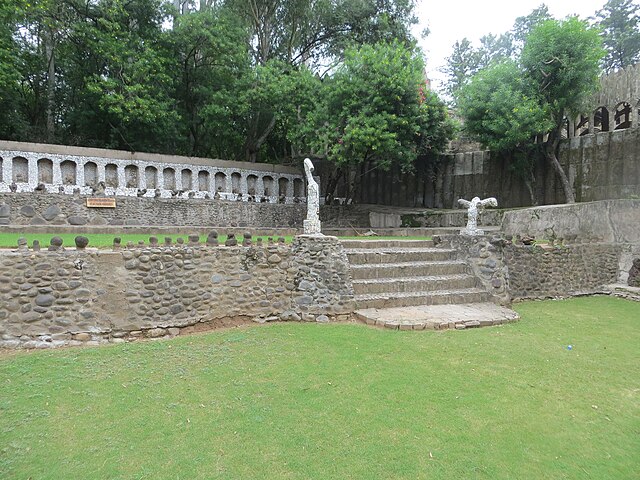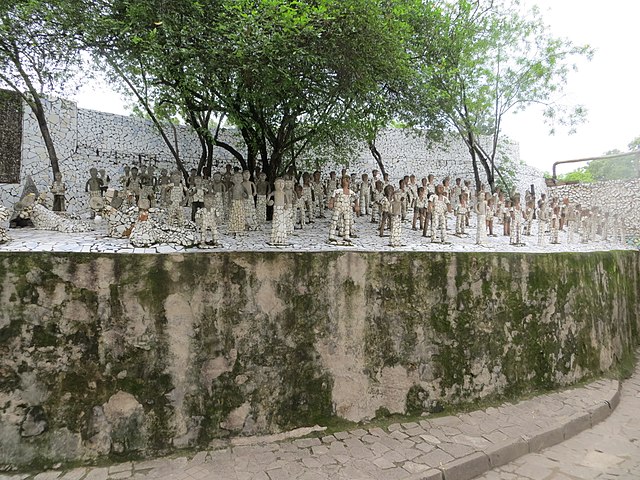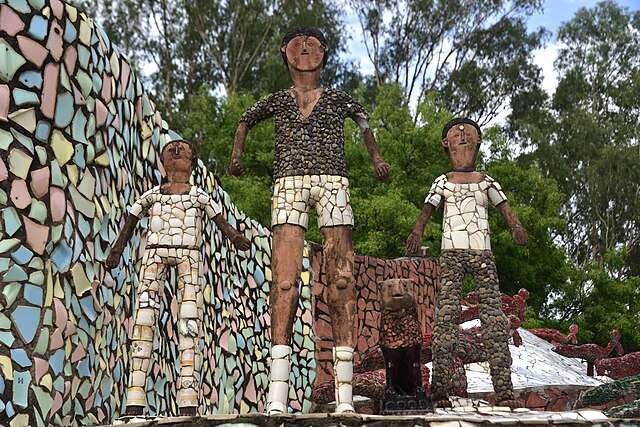Have you ever wandered through a place that feels like a fairytale brought to life, crafted from the most unexpected materials? That’s exactly what the Rock Garden of Chandigarh is—a sprawling, whimsical masterpiece born from one man’s vision to turn trash into treasure. Nestled in the heart of Chandigarh, India, this 40-acre sculpture garden is a testament to human creativity, environmental consciousness, and sheer determination. Created by Nek Chand Saini, a humble government worker, the Rock Garden transforms discarded items like broken bangles, tiles, and industrial waste into a mesmerizing world of art. Let’s take a journey through this enchanting place, exploring its history, artistry, and why it’s a must-visit for anyone craving inspiration.
The Origins of a Dream: Nek Chand’s Vision

Imagine stumbling upon a hidden oasis, crafted in secrecy under the cover of night. That’s how the Rock Garden began in 1957, when Nek Chand, a road inspector, started collecting discarded materials from Chandigarh’s construction sites. Driven by a passion for art and a vision of a divine kingdom called Sukrani, he worked alone in a forested gorge near Sukhna Lake. For nearly two decades, Nek Chand toiled in secret, shaping waste into sculptures without anyone knowing. Can you picture the dedication it took to create something so grand without recognition? His clandestine efforts laid the foundation for what would become one of India’s most iconic landmarks.
A Secret Uncovered
In 1975, the authorities discovered Nek Chand’s hidden creation, which had grown to cover 12 acres. Instead of demolishing it, they recognized its brilliance and decided to support it. By 1976, the Rock Garden was officially inaugurated, opening its gates to the public. This moment marked a turning point, transforming a personal passion project into a celebrated cultural treasure. Nek Chand’s story reminds us that sometimes, the most extraordinary creations start in the shadows, waiting for the world to catch up.
A Canvas of Recycled Art
Walking through the Rock Garden feels like stepping into an artist’s imagination. Every corner is alive with sculptures made from recycled materials—think broken ceramic pots, shattered glass, old tiles, and even discarded electrical components. These aren’t just random objects thrown together; they’re carefully crafted into figures of dancers, animals, soldiers, and villagers. The garden’s eco-friendly ethos is a powerful reminder that beauty can be found in the things we often overlook. Have you ever thought about what treasures might be hiding in your own backyard?
The Three Phases of Creativity
The Rock Garden is divided into three distinct phases, each with its own unique charm. Phase 1 welcomes you with courtyards filled with human and animal figures, crafted from broken tiles and glass. It’s like walking through a quirky village frozen in time. Phase 2 transports you to a traditional Indian village, complete with carved huts, temples, and winding pathways. Finally, Phase 3 is a grand finale, featuring a massive waterfall, an amphitheater, and giant swings adorned with mosaic animals. Each phase feels like a new chapter in a storybook, inviting you to lose yourself in its magic.
Phase 1: The Welcoming Courtyards
Entering Phase 1 is like stepping into a whimsical playground. Sculptures of people and animals, made from toilet fixtures and broken bangles, line the paths. The creativity here is infectious—every piece tells a story of transformation. It’s a reminder that even the most mundane objects can become art with a little imagination.
Phase 2: A Village Reimagined
Phase 2 feels like a journey back to rural India. The pathways mimic village streets, with sculptures of huts and temples crafted from waste. It’s as if Nek Chand captured the soul of a village and gave it a new life. Walking here, you can almost hear the chatter of villagers and the clink of pottery.
Phase 3: The Grand Spectacle
Phase 3 is where the Rock Garden truly shines. A towering waterfall cascades over the landscape, and an amphitheater hosts cultural events. Giant swings decorated with mosaic animals add a playful touch. This phase is a celebration of scale and ambition, showing what’s possible when creativity knows no bounds.
Why the Rock Garden Matters

The Rock Garden isn’t just a tourist spot; it’s a symbol of innovation and sustainability. In a world obsessed with newness, Nek Chand’s work challenges us to rethink waste. His sculptures prove that beauty can emerge from the discarded, inspiring artists and environmentalists alike. Have you ever considered how a single person’s vision could change the way we see the world?
A Global Inspiration
The Rock Garden has captured the imagination of people worldwide. Artists, architects, and eco-enthusiasts flock to Chandigarh to witness Nek Chand’s legacy. Exhibitions of his work have traveled to museums in the USA, UK, and Europe, spreading his message of creativity and conservation. It’s a reminder that art can transcend borders and speak to universal truths.
Exploring the Rock Garden: What to Expect
Visiting the Rock Garden is like embarking on an adventure. The maze-like paths keep you guessing, with surprises around every corner. You’ll encounter over 5,000 sculptures, from tiny figurines to towering installations. The garden’s layout encourages exploration, with narrow passages opening into vast courtyards. Be prepared for a bit of a walk—comfortable shoes are a must! The uneven terrain and steps add to the charm, making every visit feel like a treasure hunt.
The Dolls Museum
Tucked inside the garden is a hidden gem: the Dolls Museum. Inaugurated in 2017 to honor Nek Chand, it showcases 200 rag dolls made from waste cloth. These dolls, created in the 1970s, add a nostalgic touch to the garden’s eclectic collection. It’s a small but delightful stop that highlights Nek Chand’s versatility as an artist.
The Wishing Well
One quirky feature is the artificial wishing well, a three-foot-deep structure inspired by a real well in a nearby village. Visitors toss coins and even currency notes, believing it brings good luck. The money collected is used for the garden’s upkeep, turning wishes into practical support. Have you ever made a wish at a place like this?
Challenges and Controversies
Despite its popularity, the Rock Garden faces challenges. The sculptures, made from fragile materials, suffer from weather and wear. Maintenance is a constant battle, and recent controversies, like the 2025 demolition of a section of the garden’s wall for a parking lot, have sparked outrage. Locals and Nek Chand’s family have protested
Preserving a Legacy
The Nek Chand Foundation, along with local authorities, works tirelessly to preserve the garden. Efforts like the Kohler Foundation’s million-dollar restoration project aim to protect the fragile sculptures. However, incidents like the demolition highlight the ongoing struggle to balance heritage with modern development. It’s a poignant reminder of the need to protect cultural treasures in a rapidly changing world.
Planning Your Visit
Ready to explore this wonderland? The Rock Garden is open daily from 9 AM to 7 PM (6 PM in winter), with entry fees of ₹30 for adults and ₹10 for children. The best time to visit is from October to March, when the weather is cooler and festive decorations add extra charm. Avoid weekends if you prefer a quieter experience, as the garden attracts thousands daily.
Getting There
Located in Sector 1, Chandigarh, the Rock Garden is easily accessible by local buses, taxis, or rickshaws. Chandigarh’s well-connected road and rail networks make it a breeze to reach from nearby cities like Delhi. The airport, 11 km away, offers taxi services for convenient transfers.
Tips for a Great Visit
Wear comfortable shoes for the uneven paths, and bring a water bottle, as the garden’s size means you’ll be walking a lot. Photography is allowed, so capture those stunning sculptures! Visit early in the morning for cooler weather and fewer crowds. Don’t miss nearby attractions like Sukhna Lake or the Capitol Complex for a full Chandigarh experience.
The Rock Garden’s Cultural Impact

The Rock Garden is more than art—it’s a cultural phenomenon. It hosts events like the Teej festival, where the garden transforms into a festive hub. Its influence extends beyond Chandigarh, inspiring eco-art movements globally. Nek Chand’s legacy lives on, urging us to find beauty in the everyday and care for our planet.
Conclusion
The Rock Garden of Chandigarh is a living testament to the power of imagination and sustainability. Nek Chand’s vision transformed waste into a world of wonder, proving that art can change perspectives and inspire change. Whether you’re an art lover, an eco-warrior, or simply curious, this garden offers a unique experience that lingers long after you leave. So, plan your visit, toss a coin in the wishing well, and let the Rock Garden cast its spell on you.
Frequently Asked Questions
1. What is the Rock Garden of Chandigarh?
The Rock Garden is a 40-acre sculpture garden in Chandigarh, India, created by Nek Chand Saini using recycled materials like broken tiles, glass, and industrial waste, featuring thousands of artistic installations.
2. How much is the entry fee for the Rock Garden?
The entry fee is ₹30 for adults and ₹10 for children, making it an affordable attraction for all visitors.
3. What are the best months to visit the Rock Garden?
The best time to visit is from October to March, when the weather is cooler and the garden often features festive decorations.
4. Are there other attractions near the Rock Garden?
Yes, nearby attractions include Sukhna Lake, the Capitol Complex, Zakir Hussain Rose Garden, and Sector 17’s vibrant markets.
5. Can I take photos in the Rock Garden?
Yes, photography is allowed, so you can capture the stunning sculptures and share your experience.

